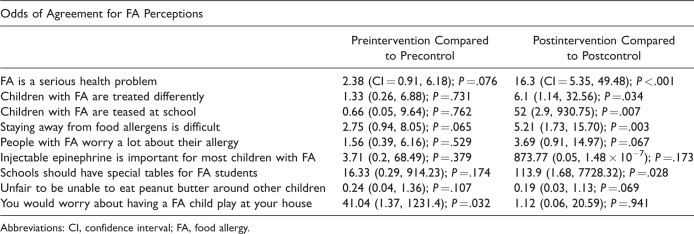Role of Food Allergy Education: Measuring Teacher Knowledge, Attitudes, and Beliefs.
IF 1.2
Q1 OTORHINOLARYNGOLOGY
引用次数: 15
Abstract
Introduction Almost 6 million children suffer from food allergies with roughly 2 affected per classroom. Deficiencies in knowledge and discrepancies in attitudes within school staff when addressing food allergies are associated with barriers to care. In this study, school teacher knowledge, beliefs, and attitudes were measured before and after a food allergy educational session. Methods Three hundred seventy-five personnel of similar age, socioeconomic status, ethnicity, and educational level completed the Chicago Food Allergy Research survey before and after a 1-hour educational session in 6 private schools in Houston randomly assigned into an intervention (n = 4) and control group (n = 2). Responses were measured using frequencies and percentages. The group score differences and survey question comparisons were evaluated with a linear mixed-effects model. Results Posttest, the intervention group had knowledge scores 19.58% points higher than control (95% confidence interval = 16.62–22.53; P < .001) with no differences pretest. Odds of agreeing that injectable epinephrine is important was higher in the intervention schools posteducation. Within the intervention group, personnel were more likely to agree to injectable epinephrine use for children posteducation. Conclusion A 1-hour educational session improved knowledge and attitudes in personnel in the intervention schools. Given the growing prevalence of food allergy, the emphasis on food allergy education is crucial to allow for familiarization of the condition, early recognition of anaphylaxis, and promotion of injectable epinephrine use.


食物过敏教育的作用:测量教师的知识、态度和信念。
导读:近600万儿童患有食物过敏,每个教室大约有2名儿童受到影响。在处理食物过敏时,学校工作人员的知识不足和态度差异与护理障碍有关。在这项研究中,学校教师的知识、信念和态度在食物过敏教育课程前后被测量。方法:375名年龄、社会经济地位、种族和受教育程度相似的人员在休斯敦6所私立学校接受1小时教育前后完成了芝加哥食物过敏研究调查,随机分为干预组(n = 4)和对照组(n = 2)。使用频率和百分比来测量反应。采用线性混合效应模型评估组间得分差异和问卷问题比较。结果:干预组知识得分较对照组提高19.58%分(95%置信区间= 16.62 ~ 22.53;结论:1小时的教育课程改善了干预学校人员的知识和态度。鉴于食物过敏的日益流行,强调食物过敏教育是至关重要的,以允许熟悉的条件,早期识别过敏反应,并促进注射肾上腺素的使用。
本文章由计算机程序翻译,如有差异,请以英文原文为准。
求助全文
约1分钟内获得全文
求助全文

 求助内容:
求助内容: 应助结果提醒方式:
应助结果提醒方式:


